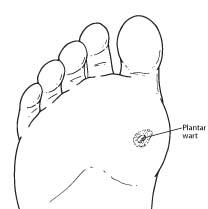Warts
Plantar warts, also known as verrucas, appear on the soles of the feet and can cause a lot of pain. Unlike other foot warts, plantar warts tend to be hard and flat, with a rough surface and well-defined boundaries with a pinpoint black center. Plantar warts are often contracted by walking barefoot on dirty surfaces or littered ground. The virus that causes plantar warts thrives in warm, moist environments, making infection a common occurrence in public pools and locker rooms.
Most foot warts are harmless, even though they may be painful. They are often mistaken for corns or calluses, which are layers of dead skin that build up to protect an area which is being continuously irritated. A wart, however, is caused by a viral infection which invades the skin through small or invisible cuts and abrasions. Foot warts are generally raised and fleshy and can appear anywhere on the foot or toes. Occasionally, warts can spontaneously disappear after a short time, and then, just as frequently, they recur in the same location. If left untreated, warts can grow to an inch or more in circumference and can spread into clusters of warts. Children, especially teenagers, tend to be more susceptible to warts than adults.
Plantar warts, also known as verrucas, appear on the soles of the feet and are one of several soft tissue conditions that can be quite painful. Unlike other foot warts, plantar warts tend to be hard and flat, with a rough surface and well-defined boundaries. They are often gray or brown (but the color may vary), with a center that appears as one or more pinpoints of black. Plantar warts are often contracted by walking barefoot on dirty surfaces or littered ground. The virus that causes plantar warts thrives in warm, moist environments, making infection a common occurrence in public pools and locker rooms.
Like any other infectious lesion, plantar warts are spread by touching, scratching, or even by contact with skin shed from another wart. The wart may also bleed, another route for spreading. Plantar warts that develop on the weight-bearing areas of the foot (the ball or heel of the foot) can cause a sharp, burning pain. Pain occurs when weight is brought to bear directly on the wart, although pressure on the side of a wart can create equally intense pain.
To prevent the spread of warts, follow these tips:
- Avoid direct contact with warts, both from other persons or from other parts of the body.
- Avoid walking barefoot, except on sandy beaches.
- Change your shoes and socks daily.
- Check your children’s feet periodically.
- Keep your feet clean and dry.
It is important to note that warts can be very resistant to treatment and have a tendency to recur. Over-the-counter foot wart treatments are usually ineffective because their use can inadvertently destroy surrounding healthy tissue. Please contact our office for help in effectively treating warts. Our practice is expert in recommending the best treatment for each patient, ranging from prescription ointments or medications to, in the most severe cases, laser cautery.
What is a Plantar Wart?
A wart is a small growth on the skin that develops when the skin is infected by a virus. Warts can develop anywhere on the foot, but typically they appear on the bottom (plantar side) of the foot. Plantar warts most commonly occur in children, adolescents, and the elderly.
There are two types of plantar warts:
- A solitary wart is a single wart. It often increases in size and may eventually multiply, forming additional “satellite” warts.
- Mosaic warts are a cluster of several small warts growing closely together in one area. Mosaic warts are more difficult to treat than solitary warts.

Causes
Plantar warts are caused by direct contact with the human papilloma virus (HPV). This is the same virus that causes warts on other areas of the body.
Symptoms
The symptoms of a plantar wart may include:
- Thickened skin. Often a plantar wart resembles a callus because of its tough, thick tissue.
- Pain. Walking and standing may be painful. Squeezing the sides of the wart may also cause pain.
- Tiny black dots. These often appear on the surface of the wart. The dots are actually dried blood contained in the capillaries (tiny blood vessels).
Plantar warts grow deep into the skin. Usually this growth occurs slowly, with the wart starting small and becoming larger over time.
Diagnosis and Treatment
To diagnose a plantar wart, the foot and ankle surgeon will examine the patient’s foot and look for signs and symptoms of a wart.
Although plantar warts may eventually clear up on their own, most patients desire faster relief. The goal of treatment is to completely remove the wart.
The foot and ankle surgeon may use topical or oral treatments, laser therapy, cryotherapy (freezing), acid treatments, or surgery to remove the wart.
Regardless of the treatment approaches undertaken, it is important that the patient follow the surgeon’s instructions, including all home care and medication that has been prescribed, as well as follow-up visits with the surgeon. Warts may return, requiring further treatment.
If there is no response to treatment, further diagnostic evaluation may be necessary. In such cases, the surgeon can perform a biopsy to rule out other potential causes for the growth.
Although there are many folk remedies for warts, patients should be aware that these remain unproven and may be dangerous. Patients should never try to remove warts themselves. This can do more harm than good.
